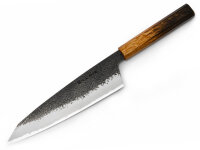"JIKKO Kureta wa Gyuto 240"
Jikko Cutlery, founded in 1883/1901, headquartered in Sakai, Osaka Prefecture.
Jikko Cutlery specializes in handcrafting Sakai knives, which have a tradition of more than 600 years. From forging the steel, grinding the raw shape to finishing, all the work for Minako knives is done in-house. Even though Sakai knives are made by hand and thus there are small differences, the products stand out for their very careful workmanship and the high-quality materials. The forge is managed in the fourth generation by Toshiyuki Minamitsu. In the beginning, knives were made exclusively for professional chefs. The cooperation with professional chefs was very intensive from the beginning. Over the long period of time, Jikko has collected more than 100,000 wishes and suggestions from chefs and incorporated them into the further development of its products. Only since a few years Jikko sells the knives also to private interested parties. For this purpose, own stores were also founded in Japan. The number of enthusiastic customers has grown rapidly. Jikko's philosophy is convincing: we enjoy hard work that puts a smile on customers' faces when they cook.
Kureta wa knife series
Kureta wa is the name of the series because of the beautiful hammering with which the Kuroshiage blade is equipped. The knife series Kureta wa has blades made of the famous Aogami super steel, black forged and polished, the handles are made of Rosewood (Rosewood), octagonal shape. This knife is produced in classic shapes Petty, Gyuto and Santoku.
How to use
Japanese chef's knives are made of extremely hard steels and are forged and ground thinner than their European counterparts. Some of these knives have very finely ground cutting layers, making them more delicate and suitable only for soft cut foods. Please refer to the product details for information in this regard. In particular, knives with a very thin cutting edge and hollow grind are prone to chipping on the blade. These are excellent for fine cuts of soft cut material, but should be used with appropriate care. Sharpening on a whetstone usually produces an angled grind, which makes the edge more stable over time.
Breakouts on the cutting edge can also occur due to leverage forces as well as frozen cuttings, which significantly reduce the temperature of the steel. Leverage forces often occur when cutting material with bones, for example. Chipping on the cutting edge may need to be ground out by a professional.
The knife should always be guided straight with pulling or pushing cut, without much pressure. To maintain sharpness, avoid cutting on stone, glass or other hard surfaces. Never use \"sharpening steel\" for resharpening. Water sharpening stones are recommended (grit: 400-1200 for preliminary sharpening, 3000 for fine sharpening, 6000 or more to strip the blade) and a honing leather if necessary.
Please keep the knife away from children. These knives are extremely sharp, please be careful.
All products are unique, so slight deviations from the exemplary picture are possible.
Care instructions
When using knives made of delicate types of steel, such as Aogami, Shirogami or V-Toku, please clean them occasionally with a cloth and water even during prolonged use. However, acidic foods can still cause discoloration on these classic carbon steels. After use, please wash by hand with hot water and use a neutral dishwashing detergent if necessary. Please do not put the knife in the dishwasher under any circumstances. After cleaning, dry thoroughly, oil if necessary, and store in a well-ventilated area. Residual moisture can cause rust in non-stainless steels. See our posts on the ORYOKI Japan blog for product care.
Clean the knife by hand and do not use a dishwasher. Dry it thoroughly afterwards.


















